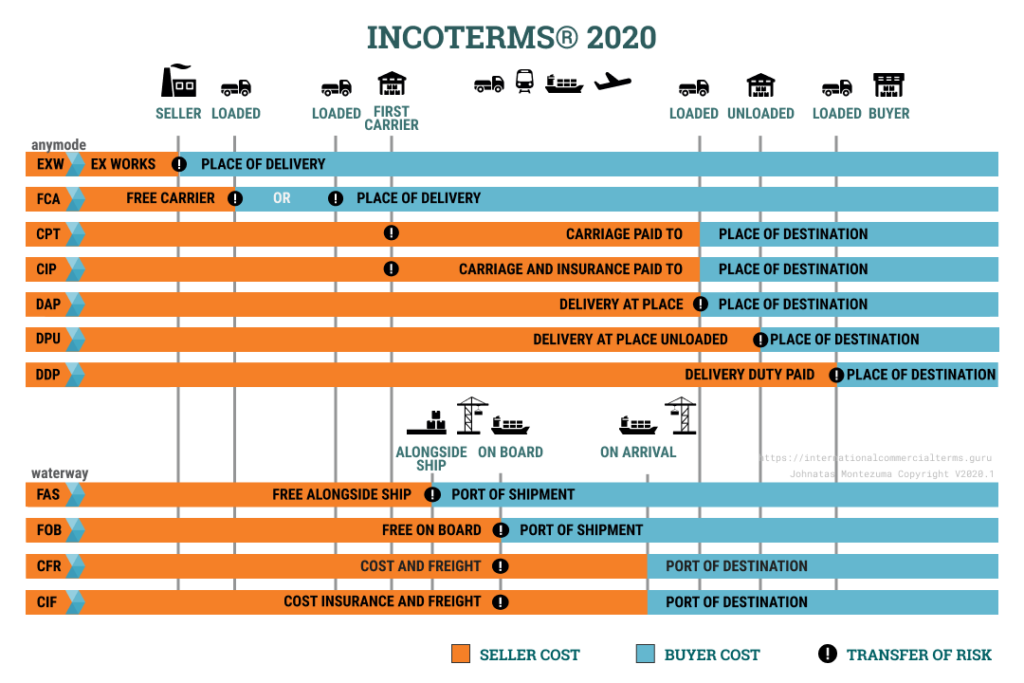The Incoterms® rules, also known as International Commercial terms, are a series of pre-defined commercial terms that have been published by the International Chamber of Commerce (ICC). There are up to 11 of these international shipping agreements, and two of them (FOB and CIF) are among the most widely used in international commercial maritime transactions. That is why in this blog we bring some clarity and explain their similarities and differences.

Similarities
Both rules can be used only in the event that the commercial operation makes use of maritime transport or inland waterways. In both cases, the seller must supply the goods and their corresponding commercial invoice, and bear the risks of possible loss or damage caused to the goods until delivery. And after that, the buyer will be the one that taks all of the responsibility.
In both FOB and CIF rules, the seller has an obligation to load the goods on the vessel that is going to make the main journey. Once this has been validated, all costs and everything that happens in the rest of the journey is the responsibility of the buying company. The entire processes of packaging and packaging, loading of the goods and transport to the port, the necessary export procedures (customs, permits and even tax documents), any type of official authorization, and the costs of maneuvering and storing on the vessel that will make the main journey, are borne by the seller for both incoterms. In addition, it is also common in both rules that the buyer assumes responsibility for obtaining the license, official authorization, and carrying out the customs procedures necessary for the importation of the goods.
In both rules, it is the buyer who must take care of the receipt of the goods when it has been delivered to the port of destination.
In both cases, the seller must give the seller any notice that allows the buyer to take the necessary measures to proceed with the receipt of the goods.
Also, the seller shall provide the buyer with the transport document as proof that the goods have been delivered in accordance with the provisions, for example, on the ship of the country of origin.
For both FOB and CIF, it is the seller who will run with all the costs of quality verification operations, weights, counts and etc that are required in order to guarantee the delivery of the goods correctly with the provisions and to be able to issue the aforementioned transport document. The seller shall assist the buyer with any documents and information he/she needs for the importation of the goods or their transport to the final destination, and the costs arising from obtaining this information shall be borne by the buyer. In turn, the buyer must assist the seller with any documents and information he needs for the export of the goods or their transport to the final destination.
In both incoterms, the risks and losses arising from the time of delivery (on the ship) of the goods to the destination endpoint are the responsibility of the buyer.

Differences
In the FOB rule, being an incoterm of Group F, the buyer assumes more obligations than the seller. But, in the CIF rule, being an incoterm of Group C, the seller assumes more obligations than the buyer.
In the FOB incoterm, it is the buyer who contracts the carrier who will make the main journey from the port of origin to an agreed point of the port of destination (although the seller could assume this responsibility if the parties so decide). However, in the CIF incoterm, it is the seller who is responsible for the contracting of the main logistics operator in a mandatory way.
In the FOB rule, it is the buyer who is responsible for carrying out the transport insurance, since the seller has no obligation to do so and it is the most recommended and usual (although the seller is obliged to send him all the information that the buyer needs to obtain the insurance). On te contrary, in the CIF rule, the insurance must be contracted by the seller mandatory. This insurance must also be contracted to a recognized insurance company, and the insurance must also cover the minimum coverage provided by clauses (C) of the Institute’s Cargo Clauses (LMA/IUA) or other similar clauses.
From the above difference you can infer a new one: in the FOB rule, since the buyer contracts the insurance, it will be taken into account in the negotiation to ensure the entire trip that the goods will make under optimal conditions. But, in the CIF rule, being the seller who contracts the insurance, the transport insurance from the port to the buyer’s premises may not be given too much importance.
In the FOB rule, the buyer, by taking responsibility for taking out the insurance and the main carrier, knows or has greater control over the costs of the operation that he is carrying out and, therefore, reduce the total costs. Meanwhile, in the CIF rule, being the seller who assumes these two responsibilities, it is the seller who has the advantage of controlling this important part to improve their profit margin. That’s why, while the FOB rule is more recommended for buyers, the CIF rule is more recommended for sellers.

